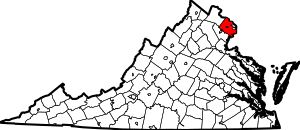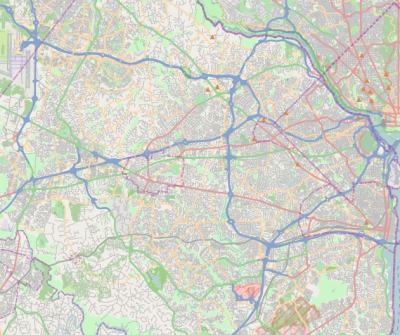|
Fairfax County, Virginia
Fairfax County, officially the County of Fairfax, is a county in the Commonwealth of Virginia. With a population of 1,150,309 as of the 2020 census,[1] it is the most populous county in Virginia, the most populous jurisdiction in the Washington metropolitan area, and the most populous location in the Washington–Baltimore combined statistical area. The county seat is Fairfax; however, because it is an independent city under Virginia law, the city of Fairfax is not part of the county.[2] The county is part of the Northern Virginia region and forms part of the suburban ring of Washington, D.C., the nation's capital. The county is predominantly suburban with some urban and rural pockets. It borders Montgomery County, Maryland to its north, Falls Church, Alexandria, Arlington County, and Prince George's County, Maryland to its east, Charles County, Maryland to its southeast, Prince William County to its southwest, and Loudoun County to its northwest. The county is home to the offices of the director of national intelligence in McLean and the headquarters of four U.S. intelligence agencies: the Central Intelligence Agency at the George Bush Center for Intelligence in Langley, the National Geospatial-Intelligence Agency in Springfield, the National Reconnaissance Office in Chantilly, and the National Counterterrorism Center in McLean. In academia, the county is home to the flagship campus of George Mason University in Fairfax, CIA University in Chantilly, Sherman Kent School for Intelligence Analysis in Reston, and several Northern Virginia Community College campuses. In the private sector, ten of the Fortune 500 companies are headquartered in the county as of 2023.[3] As of 2020, Fairfax County's median household income of $127,866 is the fifth-highest in the nation. History   Prior to European settlement, present-day Fairfax County was initially inhabited by the Algonquian-speaking Doeg tribe. 17th centuryIn 1608, Captain John Smith documented the Doeg tribe's villages, which included Namassingakent and Nemaroughquand on the south bank of the Potomac River in present-day Fairfax County.[5] By 1670, Virginian colonists from the Northern Neck region drove the Doeg Tribe out of present-day Fairfax County and into Maryland. 18th centuryFairfax County was formed in 1742 from the northern part of Prince William County, and was named after Thomas Fairfax, 6th Lord Fairfax of Cameron, proprietor of the Northern Neck.[6][7] The Fairfax family name is derived from the Old English phrase for "blond hair", Fæger-feax. The county's initial settlements were along the Potomac River. George Washington settled in Fairfax County and built his home, Mount Vernon, facing the Potomac. Gunston Hall, the home of George Mason, is nearby. Fort Belvoir is partly on the estate of Belvoir Manor, built along the Potomac by William Fairfax in 1741. Thomas Fairfax, the only member of the British nobility ever to reside in the colonies, lived at Belvoir before moving to the Shenandoah Valley. The Belvoir mansion and several of its outbuildings were destroyed by fire immediately after the Revolutionary War in 1783, and George Washington noted the plantation complex deteriorated into ruins. In 1757, the northwestern two-thirds of Fairfax County became Loudoun County. In 1789, part of Fairfax County was ceded to the federal government to form Alexandria County, then part of the District of Columbia. 19th centuryAlexandria County was returned to Virginia in 1846, reduced in size by the secession of the independent city of Alexandria in 1870, and renamed Arlington County in 1920. During the American Civil War the Battle of Chantilly, also known as Ox Hill, part of the Second Battle of Bull Run, was fought within Fairfax County. Other areas of Civil War conflict in the county included Minor's Hill, Munson's Hill, and Upton's Hill. 20th centuryThe Fairfax County town of Falls Church became an independent city in 1948.[8] The Fairfax County town of Fairfax was named an independent city in 1961.[9] The federal government's growth during and after World War II spurred rapid growth in the county and transformed it from a rural to suburban region. Large businesses began settling in the county, and the opening of Tysons Corner Center spurred the rise of Tysons, Virginia. The technology boom and a steady government-driven economy created rapid growth and an increasingly large and diverse population. The economy has also made Fairfax County one of the nation's wealthiest counties.[10] A general aviation airport along U.S. Route 50 west of Seven Corners, Falls Church Airpark, operated in the county from 1948 to 1960. The facility's 2,650-foot unpaved runway was used extensively by private pilots and civil defense officials. Residential development, multiple accidents, and the demand for retail space led to its closure in 1960.[11][12][13] Geography and climateAccording to the U.S. Census Bureau, the county has an area of 406 square miles (1,050 km2), of which 391 square miles (1,010 km2) is land and 15 square miles (39 km2) (3.8%) is water.[14] There are about 44,400,000 trees that create a canopy covering 55.4% of the total land area.[15] Fairfax County is bounded on the north and southeast by the Potomac River. Across the river to the northeast is Washington, D.C., across the river to the north is Montgomery County, Maryland, and across the river to the southeast are Prince George's County, Maryland and Charles County, Maryland. The county is partially bounded on the north and east by Arlington County and the independent cities of Alexandria and Falls Church. It is bounded on the west by Loudoun County, and on the south by Prince William County. Most of the county lies in the Piedmont region, with rolling hills and deep stream valleys, such as Difficult Run and its tributaries. West of Route 28, the hills give way to a flat, gentle valley that stretches west to the Bull Run Mountains in Loudoun County. Elevations in the county range from near sea level along the tidal sections of the Potomac River in the southeast portion of the county to more than 500 feet (150 m) in the Tysons area. In 2023, the plant hardiness zone shifted from 7a to 7b. The Fairfax County News Letter predicts that Fairfax will shift to zone 8 in the next few decades as temperatures rise.[16] Adjacent jurisdictions
GeologyThe Piedmont hills in the central county are made up of ancient metamorphic rocks such as schist, the roots of several ancestral ranges of the Appalachian Mountains. The western valley is floored with more recent shale and sandstone. This geology is similar to adjacent bands of rocks in Maryland and further south in Virginia along the eastern front of the Appalachian. An area of 11 square miles (30 km2) of the county is known to be underlain with natural asbestos.[17] Much of the asbestos is known to emanate from fibrous tremolite or actinolite. The threat was discovered in 1987, prompting the county to establish laws to monitor air quality at construction sites, control soil taken from affected areas, and require freshly developed sites to lay 6 inches (150 mm) of clean, stable material over the ground.[18][19] During the construction of Centreville High School, for instance, a large amount of asbestos-laden soil was removed and then trucked to Vienna for the construction of the I-66/Nutley Street interchange. Fill dirt then had to be trucked in to make the site level.[citation needed] Marine clays can be found in widespread areas of the county east of Interstate 95, mostly in the Franconia and Mount Vernon districts. These clays contribute to soil instability, leading to significant construction challenges for builders.[20] Government and politics
Fairfax County uses the urban county executive form of government, which county voters approved in a 1966 referendum.[21][22] Under the urban county executive plan, the county is governed by the 10-member Fairfax County Board of Supervisors with the day-to-day running of the county tasked to the appointed Fairfax County executive. Nine of the board members are elected from the single-member districts of Braddock, Dranesville, Franconia, Hunter Mill, Mason, Mount Vernon, Providence, Springfield, and Sully, while the chairman is elected at-large.[23] In addition to the Board of Supervisors, three constitutional officers, the Commonwealth's Attorney, clerk of the Circuit Court, and sheriff. The Fairfax County School Board has 12 members that are directly elected by the voters of Fairfax County. Fairfax County also has a Consumer Protection Commission. The Commission advises the Board of Supervisors and the Department of Cable and Consumer Services on consumer affairs, investigates illegal, fraudulent, deceptive, or dangerous consumer practices, and refers apparent violations of Virginia law to the Commonwealth Attorney or County Attorney for investigation.[24] The Fairfax County Government Center is west of the City of Fairfax in an unincorporated area.[25] Fairfax County contains an exclave unincorporated area in the City of Fairfax's central business district, where many county facilities (including the courthouses and jail) are.[26][27] Fairfax County was once considered a Republican bastion but Democrats now control of the Board of Supervisors and the School Board (officially nonpartisan) as well as the offices of sheriff and Commonwealth's Attorney. Democrats also hold all the Fairfax seats in the Virginia House of Delegates and every seat in the Senate.[citation needed] Fairfax County encompasses parts of three congressional districts, the 8th District, the 10th District, and the 11th District. Democrats represent all three districts, with Jennifer Wexton representing the 10th, Don Beyer representing the 8th, and Gerry Connolly representing the 11th. In the 2012 general election, Fairfax County solidly backed Obama for reelection as president, who came just short of matching his 2008 performance, winning the county 59.6% to 39.1%. Former Governor Tim Kaine, running for the U.S. Senate in 2012, carried Fairfax County with 61% of the vote as part of his statewide victory. Representatives Connolly, Moran, and Wolf were also reelected. Although Republican governor Bob McDonnell won Fairfax County with 51% of the vote in 2009, the Republican resurgence in Fairfax was short-lived. In the 2013 election, Democratic gubernatorial candidate Terry McAuliffe won Fairfax County with 58% of the vote, defeating incumbent state attorney general and former Republican state senator from Fairfax Ken Cuccinelli. McAuliffe's running mates, Ralph Northam and Mark Herring, also carried Fairfax County in their respective bids for lieutenant governor and attorney general. These Democratic victories mirrored the Democratic ticket's sweep of the state's three executive offices for the first time since 1989. In the 2016 general election, Fairfax continued its trend towards Democratic candidates. Representatives Beyer and Connolly were reelected, the latter unopposed. Fairfax County supported Hillary Clinton for president with 64.4% of the vote to Donald Trump's 28.6%, exemplifying a heavy swing toward Democrats across Northern Virginia. In the 2020 general election, Democratic presidential nominee Joe Biden won the county with 69.89% of the vote, the best percentage for a Democrat in the county since 1916.
Population2020 census
Of the households, 55.5% were married couple families, 15.9% were a male family householder with no spouse, and 23.0% were a female family householder with no spouse. The average family household had 3.25 people.[35] The median age was 39.4, 22.6% of people were under the age of 18, and 15.1% were 65 years of age or older. The largest ancestry is the 10.1% who had English ancestry, 37.8% spoke a language other than English at home, and 30.7% were born outside the United States, 63.4% of whom were naturalized citizens.[35] The median income for a household in the county was $145,164, and the median income for a family was $174,085. 7.5% of the population were military veterans, and 65.5% had a bachelors degree or higher. In the county 5.6% of the population was below the poverty line, including 5.6% of those under age 18 and 5.7% of those age 65 or over, with 7.2% of the population without health insurance.[35]
EducationK-12 education The county is served by the Fairfax County Public Schools system, to which the county government allocates 52.2% of its budget.[38] Including state and federal government contributions, along with citizen and corporate contributions, this brings the 2023 budget for the school system to $3.5 billion. The school system has estimated that, based on the 2023 fiscal year budget, the county will be spending $18,772 on each student.[39] The Fairfax County Public School system contains the Thomas Jefferson High School for Science and Technology, a Virginia Governor's School. TJHSST consistently ranks at or near the top of all U.S. high schools due to the extraordinary number of National Merit semifinalists and finalists, its students' high average SAT scores, and the number of students who annually perform nationally recognized research in the sciences and engineering. A Governor's School, TJHSST draws students from five counties Fairfax County and other Northern Virginia counties, cities, and towns. Catholic elementary and middle schools in the county fall under the Roman Catholic Diocese of Arlington and include Paul VI Catholic High School, Fairfax County's diocese-run Catholic high school, and Oakcrest School, an all-girls Catholic school in Fairfax County, which is not run by the diocese. Colleges and universitiesGeorge Mason University is just outside the city of Fairfax, near the geographic center of Fairfax County. Northern Virginia Community College (NVCC) serves Fairfax County with campuses in Annandale and Springfield and a center in Reston that is a satellite branch of the Loudoun campus. The NVCC Alexandria campus borders Fairfax County. The Central Intelligence Agency University and its Sherman Kent School for Intelligence Analysis are both located in Fairfax County, specifically in Chantilly and Reston respectively. George Mason University faculty have twice won the Nobel Prize in Economics. George Mason University economics professors James M. Buchanan and Vernon L. Smith won it in 1986 and 2002, respectively.[40] The University of Fairfax, a for-profit proprietary college and alleged diploma mill was once headquartered in Vienna, Virginia.[41][42] Virginia Commonwealth University's School of Medicine recently constructed a medical campus wing at Inova Fairfax Hospital in order to allow third- and fourth-year medical students to study at other state-of-the-art facilities in Northern Virginia.[43] Economy Fairfax County's economy revolves around professional services and technology. Many residents work for the government or contractors of the federal government. The government is the largest employer, with Fort Belvoir in southern Fairfax the county's single largest source of federal employment. Fairfax County has a gross county product of approximately $95 billion.[citation needed] Major employers in the county include Volkswagen Group of America, Hilton Worldwide,[45] DXC Technology (formerly Computer Sciences Corporation), Northrop Grumman, Science Applications International Corporation (SAIC), Leidos, Booz Allen Hamilton, Gannett, Capital One, General Dynamics, ICF International, Freddie Mac, Sallie Mae, ManTech International, Mars, NII, and NVR. The county is home to seven Fortune 500 company headquarters,[46] 11 Hispanic 500 companies,[47] and five companies on the Black Enterprise 500 list. The county's economy is supported by the Fairfax County Economic Development Authority, which provides services and information to promote Fairfax County as a leading business and technology center. The FCEDA is the nation's largest non-state economic development authority. Fairfax County is also home to the Northern Virginia Technology Council, a trade association for local technology companies.[48][49] Fairfax County has a higher concentration of high-tech workers than Silicon Valley.[50] Tysons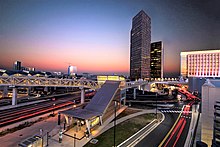 Tysons, located in the county, is Virginia's largest office market and the nation's largest suburban business district, with 26,600,000 square feet (2,470,000 m2) of office space.[51][52] It is the country's 12th-largest business district and is expected to grow substantially in the coming decades. It contains a quarter of the county's total office space inventory, which was 105,200,000 square feet (9,770,000 m2) as of 2006, representing roughly the same size as the Lower Manhattan region of New York City.[53] In October 2011, Forbes described the area as "the place where the Internet was invented, but today it looks increasingly like the center of the global military-industrial complex",[54] because it is home to the nation's first ISPs, many of which are now defunct, and attracts numerous defense contractors that have relocated from other states to or near Tysons Corner. Tysons draws over 100,000 workers from around the Washington metropolitan area, and draws 55,000 shoppers daily to its two super-regional malls, Tysons Corner Center and Tysons Galleria compared to 62,500 shoppers daily in Washington, D.C.. After years of delays attributed to stalling and controversy, the $5.2 billion expansion of the Washington Metro Silver Line in Virginia from Washington, D.C., to Dulles International Airport was funded by the Federal Transit Administration in December 2008.[55] The Silver Line added four stations in Tysons, including a station between Tysons Corner Center and Tysons Galleria. Along with the expansion of Washington Metro, Fairfax County government has a plan to "urbanize" the Tysons area. The plan calls for a private-public partnership and a grid-like street system to make Tysons a more urban environment, tripling available housing to allow more workers to live near their workplaces. The goal is to have 95% of Tysons Corner within 1⁄2-mile (800 m) of a metro station.[56] Top employersAccording to the county's 2023 Comprehensive Annual Financial Report,[57] the county's largest employers are:
Arts and culture Annual festivals include the "Celebrate Fairfax!" festival held in June at the Fairfax County Government Center in Fairfax, the Tephra Fine Arts Festival[58] held in May at Reston Town Center in Reston, and the International Children's Festival held in September at the Wolf Trap National Park for the Performing Arts, a performing arts center in Wolf Trap. Fairfax County supports a summer concert series held in multiple venues throughout the county on various nights. The concert series are called Arts in the Parks, Braddock Nights, Franconia District Nights, Mt. Vernon Nights, Nottoway Nights, Spotlight by Starlight, Sounds of Summer and Starlight Cinema.[59] Capital One Hall, part of the Capital One Headquarters Complex in Tysons, is a major performing arts center that opened in 2021 and seats 1,600 in its main theater. EagleBank Arena, originally known as the Patriot Center, is located on the Fairfax campus of George Mason University just outside Fairfax, hosts concerts and shows. The nearby Center for the Arts at George Mason is a major year-round arts venue, and the Workhouse Arts Center in Lorton, Virginia includes studios for artists, event facilities for performing groups, and gallery exhibitions in addition to hosting the annual Clifton Film Celebration.[60] Smaller local art venues include: the Alden Theater at the McLean Community Center, ArtSpace Herndon, Center Stage at the Reston Community Center, Greater Reston Arts Center, James Lee Community Center Theater, and Vienna Arts Society. TransportationRoadsSeveral major highways run through Fairfax County, including the Capital Beltway (Interstate 495), Interstate 66, Interstate 95, and Interstate 395. The American Legion Bridge connects Fairfax to Montgomery County, Maryland. The George Washington Memorial Parkway, Dulles Toll Road, and Fairfax County Parkway are also major arteries. Other notable roads include Braddock Road, Old Keene Mill Road, Little River Turnpike, State Routes 7, 28, and 123, and U.S. Routes 1, 29, and 50. The county is part of the Washington metropolitan area, the nation's third-most congested area as of 2008.[61][62][63] Northern Virginia, including Fairfax County, is the third-worst congested traffic area in the nation, in terms of percentage of congested roadways and time spent in traffic. Of the lane miles in the region, 44 percent are rated "F" or worst for congestion. Northern Virginia residents spend an average of 46 hours a year stuck in traffic. Major highways
Air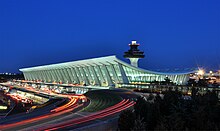 Dulles International Airport lies partly within Fairfax County and provides most air service to the county. Fairfax is also served by two other airports in the Washington area, Ronald Reagan Washington National Airport and Baltimore-Washington International Thurgood Marshall Airport. Manassas Regional Airport, in neighboring Prince William County, is also used for regional cargo and private jet service. From 1945 to 1961, the eastern part of Fairfax County hosted Falls Church Airpark, an airfield primarily used for general aviation and civil defense purposes until encroaching residential development forced its closure.[64] The area the airport occupied is now mainly used as a shopping center, with the western end of the complex occupied by the Thomas Jefferson branch of the Fairfax County Public Library system. Parts of several apartment complexes are also on some of the airport's former grounds.[11][12] Public transportation Fairfax County has multiple public transportation services, including the Washington Metro's Blue, Orange, Silver and Yellow lines. The Silver line, which runs through the Tysons, Reston, and Herndon areas of the county, opened in 2014, later extended in 2022, as the first new Washington Metro line since the Green Line opened in 1991.[65] The Virginia Railway Express (VRE) provides commuter rail service to Union Station in Washington, D.C., with stations in Fairfax County. The VRE's Fairfax County stations are Lorton and Franconia-Springfield on the Fredericksburg line, and Burke Centre, Rolling Road, and Backlick Road on the Manassas line.[66] Fairfax County contracts its bus service, the Fairfax Connector, to Transdev. The county is also served by WMATA's Metrobus service. Parks and recreationThe county has many protected areas, a total of over 390 county parks on more than 23,000 acres (93 km2).[67] The Fairfax County Park Authority maintains parks and recreation centers through the county. There are also two national protected areas that are inside the county at least in part, including Elizabeth Hartwell Mason Neck National Wildlife Refuge, George Washington Memorial Parkway, and Wolf Trap National Park for the Performing Arts. Mason Neck State Park is also in Lorton. Fairfax County is a member of the Northern Virginia Regional Park Authority. Reston Zoo is in Reston.[68] The National Zoo is nearby in Washington, D.C. TrailsThe county maintains many miles of bike trails running through parks, adjacent to roads and through towns such as Vienna and Herndon. The Washington & Old Dominion Railroad Trail runs through Fairfax County, offering one of the region's best, and safest, routes for recreational walking and biking. In addition, nine miles (14 km) of the Mount Vernon Trail runs through Fairfax County along the Potomac River. Compared to other regions of the Washington area, Fairfax County has a dearth of designated bike lanes for cyclists wishing to commute in the region. On May 16, 2008, Bike-to-Work Day, the Fairfax County Department of Transportation released the first countywide bicycle route map.[69] The Gerry Connolly Cross County Trail runs from Great Falls National Park in the county's northern end to Occoquan Regional Park in the southern end. Consisting of mostly dirt paths and short asphalt sections, the trail is used mostly by recreational mountain bikers, hikers, and horse riders. Communities  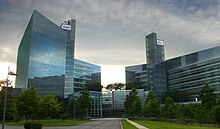  Three incorporated towns, Clifton, Herndon, and Vienna, are in Fairfax County.[70] The independent cities of Falls Church and Fairfax were formed out of areas formerly under Fairfax County's jurisdiction but are politically separate. Nevertheless, the Postal Service has long considered several portions of Fairfax County to be unincorporated Falls Church and Fairfax City. Several portions of the county also have Alexandria mailing addresses; many locals refer to these neighborhoods collectively as "South Alexandria", "Lower Alexandria", or "Alexandria, Fairfax County".[71] "South Alexandria" communities include Hollin Hills, Franconia, Groveton, Hybla Valley, Huntington, Belle Haven, Mount Vernon, Fort Hunt, Engleside, Burgundy Village, Waynewood, Wilton Woods, Rose Hill, Virginia Hills, Hayfield, and Kingstowne. It has been proposed[72] to convert the entire county into a single independent city, primarily to gain more control over taxes and roads. The most recent such proposal was made on June 30, 2009. Other communities in Fairfax County are unincorporated areas. Virginia law dictates that no unincorporated area of a county may be incorporated as a separate town or city following the adoption of the urban county executive form of government.[73] Fairfax County adopted the urban county executive form of government in 1966.[21][22] As of the 2000 census, Fairfax County's 13 largest communities are all unincorporated CDPs, the largest of which are Centreville, Reston, and McLean, each with a population over 45,000. Census-designated placesThe following localities in Fairfax County are identified by the U.S. Census Bureau as unincorporated Census-designated places:[74]
Other unincorporated communities
Population rankingThe population ranking of the following table is based on 2020 U.S. census data.[75] † county seat
Notable peopleHistoric figures 
Films and television
Government and politics
Media
Musicians
Sportspeople
Other
Sister citiesFairfax County's sister cities are:[84]
See also
Explanatory notes
Notes
External linksWikimedia Commons has media related to Fairfax County, Virginia. Wikivoyage has a travel guide for Fairfax County.
|
|||||||||||||||||||||||||||||||||||||||||||||||||||||||||||||||||||||||||||||||||||||||||||||||||||||||||||||||||||||||||||||||||||||||||||||||||||||||||||||||||||||||||||||||||||||||||||||||||||||||||||||||||||||||||||||||||||||||||||||||||||||||||||||||||||||||||||||||||||||||||||||||||||||||||||||||||||||||||||||||||||||||||||||||||||||||||||||||||||||||||||||||||||||||||||||||||||||||||||||||||||||||||||||||||||||||||||||||||||||||||||||||||||||||||||||||||||||||||||||||||||||||||||||||||||||||||||||||||||||||||||||||||||||||||||||||||||||||||||||||||||||||||||||||||||||||||||||||||||||||||||||||||||||||||||||||||||||||||||||||||||||||||||||||||||||||||||||||||||||||||||||||||||||||||||||||||||||||||||||||||||||||||||||||||||||||||||||||||||||||||||||||||||||||||||||||||||||||||||||||||||||||||||||||||||||||||||||||||||||||||||||||||||||||||||||||||||||||||||||||||||||||||||||||||||||||||||||||||||||||||||||||||||||||||||||||||||||||||||||||||||||||||||||||||||||||||||||||||||||||








